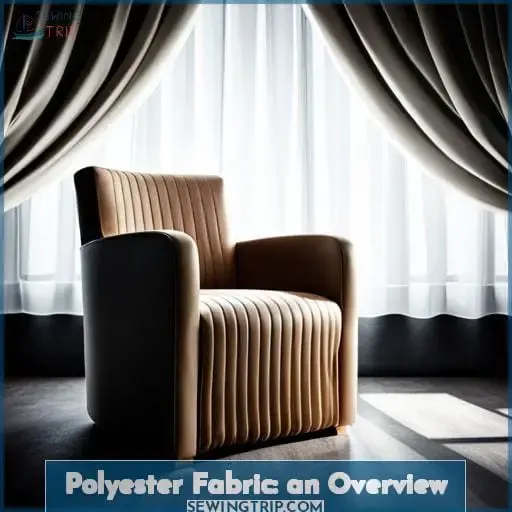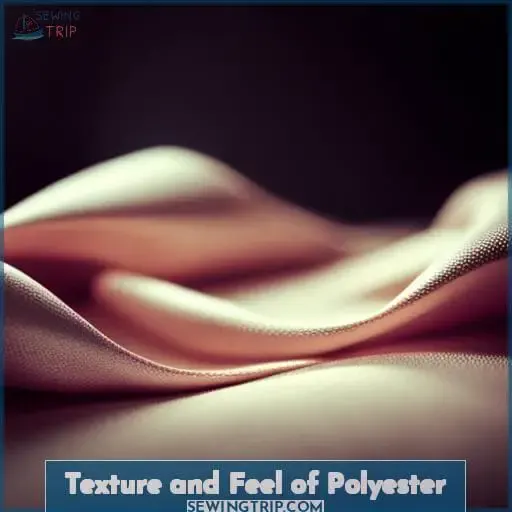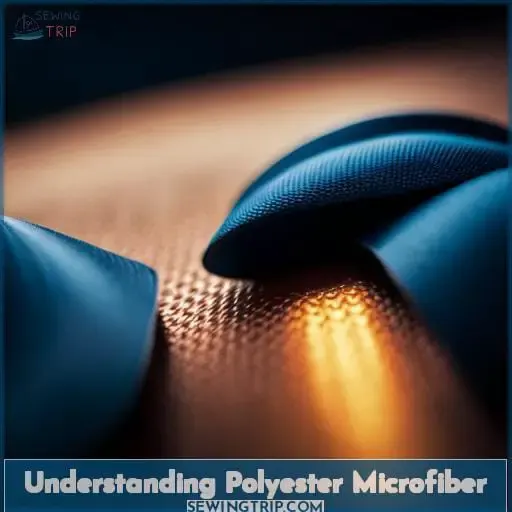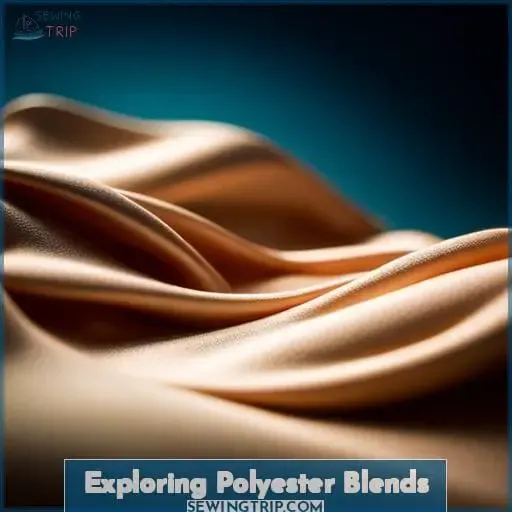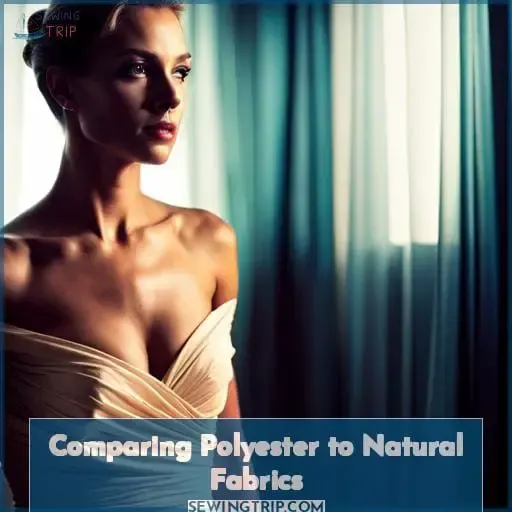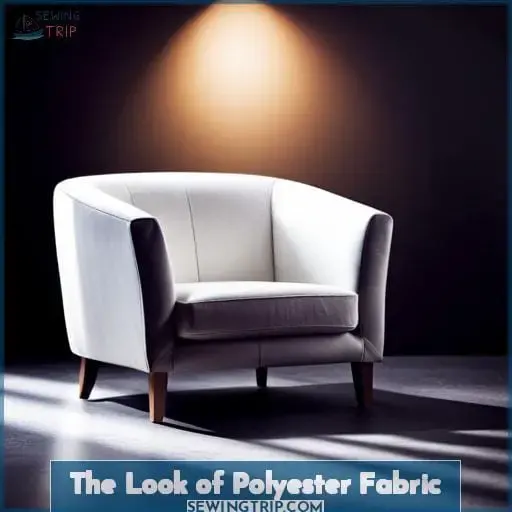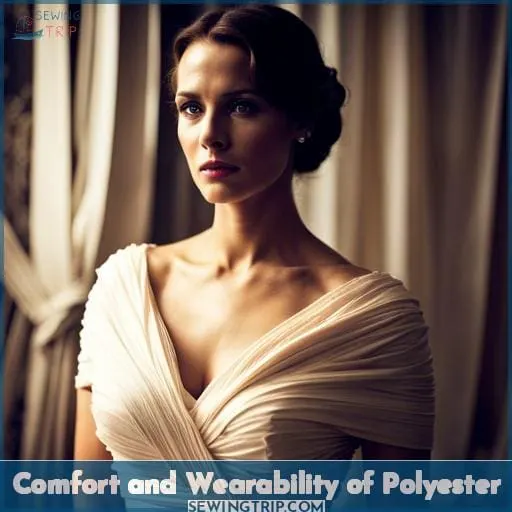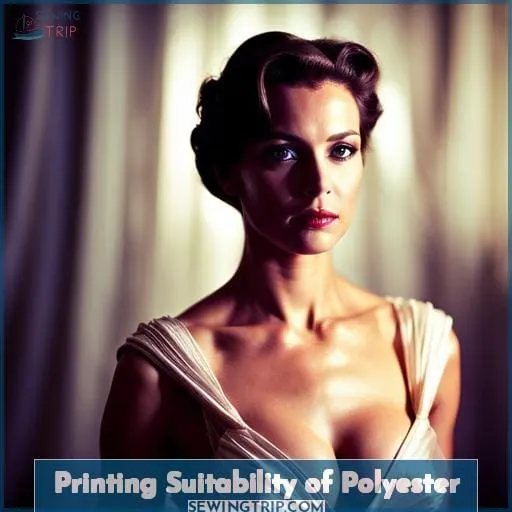This site is supported by our readers. We may earn a commission, at no cost to you, if you purchase through links.
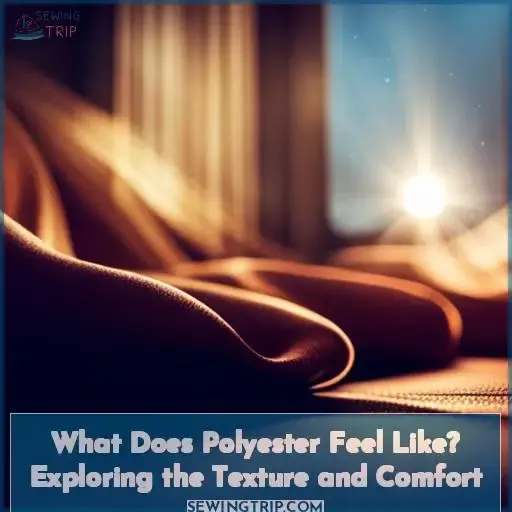
Polyester has the potential to be soft, depending on how it’s made. Polyester microfiber is extremely fine and smooth, giving it a silky feel. Regular polyester can feel crisp and papery. Lower quality polyester may feel rough and scratchy against the skin.
The texture of polyester also depends on the weave. Tightly woven polyester with a high thread count can feel smooth and flowing. Loosely woven polyester may feel coarse and stiff. Special weaving techniques like jacquard can create different textures like embossed designs.
Polyester is hydrophobic, meaning it doesn’t absorb moisture like natural fibers. This can make it feel cool and dry but less breathable. It can also create static cling.
Polyester lacks the natural elasticity of fibers like wool. It tends to hold its shape rather than draping comfortably.
While some may prefer natural fabrics, polyester has benefits like wrinkle resistance, easy care and shape retention. Preferences vary – polyester may suit those wanting a crisp, smooth feel while others favor softer natural textures.
By understanding the qualities of polyester, you can determine if it meets your needs.
Table Of Contents
- Key Takeaways
- Polyester Fabric: an Overview
- Texture and Feel of Polyester
- Understanding Polyester Microfiber
- Exploring Polyester Blends
- Comparing Polyester to Natural Fabrics
- The Look of Polyester Fabric
- Comfort and Wearability of Polyester
- Printing Suitability of Polyester
- Health Considerations With Polyester
- Making an Informed Decision
- Conclusion
Key Takeaways
- Polyester fabric can vary in texture and comfort based on factors such as microfiber, weave, and quality.
- Microfiber polyester has a silky and smooth feel, while regular polyester can feel crisp or rough.
- Weave and thread count impact the texture of polyester, with tightly woven polyester feeling smooth.
- Since polyester is hydrophobic, it is cool but less breathable and prone to static cling.
Polyester Fabric: an Overview
Polyester is a synthetic fabric made by spinning polyethylene terephthalate into fibers that are then woven or knitted into fabric. As a widely used textile, polyester is commonly found in clothing, home furnishings, and outdoor gear because of its moisture-wicking properties and durability, though some find it lacks breathability and contributes to plastic pollution.
How It’s Made
You feel the smooth, slick fabric sliding between your fingers as the sewing machine whirs, stitching together another polyester shirt. The synthetic threads begin as tiny plastic pellets melted down and spun into fibers.
Weaving them together creates a moisture-wicking, wrinkle-resistant fabric. Blending with natural fibers like cotton yields a durable, versatile textile. Yet polyester’s non-biodegradable nature raises environmental concerns. Careful recycling and reducing use can lessen its impact.
Common Uses
Take workout wear, for example—you’ll find polyester in moisture-wicking tops and leggings that keep you dry during sweat sessions. The synthetic fiber’s ability to wick moisture makes it ideal for performance apparel.
Polyester is also ubiquitous in home furnishings like curtains, upholstery, and carpeting where durability and stain resistance are valued. Outdoor gear and rainwear benefit from polyester’s water-resistant properties. Its versatility allows it to be spun into smooth, silky fabrics or thick, insulating fleeces.
Pros and Cons
When choosing fabric for apparel, consider polyester’s pros and cons. Its moisture-wicking properties make it ideal for athletic wear. However, some may experience skin irritation from continuous wear. While polyester is very durable and wrinkle-resistant, it’s not breathable in hot weather.
The material’s environmental impact is also a concern, as polyester production utilizes nonrenewable resources. Weigh these factors when selecting fabric for your needs. Polyester boasts useful qualities but also has limitations to bear in mind.
Texture and Feel of Polyester
When it comes to the texture and feel of polyester fabric, there are a few key things to consider. Polyester is a versatile synthetic material that can mimic both natural and man-made fabrics. It comes in different thicknesses and weights, ranging from sheer, lightweight polyester to thick, sturdy options.
The manufacturing process used gives polyester its softness or smoothness – it can feel silky and smooth or more plastic-like, depending on how it’s made.
Different Types of Polyester Fabric
Whether slicked with finishes or textured for casual wear, polyester’s versatility makes it adaptable across fashion realms. From slinky satins to sturdy twills, polyester’s sheen and drape attract designers.
Yet polyester also mimics cozy textures like terry and fleece for leisurewear. Blended with spandex, polyester stretches to contour bodies. Printed polyester dazzles with digital prints. Still, polyester’s synthetic origin sparks environmental concerns.
Carefully scrutinize manufacturing and end-of-life processes when selecting polyester pieces.
Softness and Smoothness
You’ll find polyester has a silky smoothness with a slightly plastic-like texture depending on the weave and manufacturing process.
- Softness evaluation
- Texture comparison
- Smoothness analysis
The feel of polyester fabric can range from slick and shiny to soft and smooth, depending on factors like the weave, fiber thickness, and finishing processes used. While 100% polyester often has more of a plastic-like feel, polyester blended with natural fibers can have improved softness and drape.
Evaluating polyester’s handfeel and comparing it to other fabrics like cotton or silk gives you a sense of the fabric’s tactile qualities.
Thickness and Weight
Polyester’s thickness can vary tremendously – from a feather-light microfiber that’s thinner than a spiderweb to a heavy, canvas-like material that feels as though it could stop bullets. As a fabric store owner, I’ve seen polyester in all weights and thicknesses. Its density impacts how it looks, feels, and performs.
Sheer, transparent poly blends contrast with thick, opaque types used in outerwear and home goods. The versatile nature of polyester allows it to adapt based on the textile’s intended use and desired texture.
Understanding Polyester Microfiber
Let’s dive into understanding polyester microfiber and what it feels like. Polyester microfiber is a very fine, synthetic fiber made of polyester material that has a soft, silky texture and is valued for its moisture-wicking properties and quick-drying abilities.
The delicate nature of microfiber polyester makes it feel smooth against the skin, while its construction pulls moisture away from the body, keeping you cool, dry, and comfortable when wearing it. The soft, silky feel comes from the very fine polyester fibers that make up the fabric.
The moisture-wicking properties come from the hydrophobic nature of polyester that does not absorb water well, so it moves moisture away from the skin rather than absorbing it. The quick-drying ability is also thanks to the hydrophobic polyester material that does not retain water.
Overall, polyester microfiber has become a popular fabric choice for athletic and outdoor wear because of its lightweight comfort and performance.
Characteristics and Properties
When shopping for apparel, remember that polyester traps sweat yet resists wrinkles, so choose wisely for your needs.
- Moisture-wicking properties
- Resistance to shrinking and wrinkling
- Durability and shape retention
The synthetic fabric doesn’t breathe well, so 100% polyester may irritate sensitive skin. Consider cotton-polyester blends for versatility, as polyester’s texture and feel vary based on manufacturing processes.
High-quality polyester mimics natural fibers like silk, so evaluate polyester’s characteristics before purchasing items.
Softness and Breathability
The softness against your skin makes it hard to tell this is a synthetic fabric. A careful touch reveals the silky smoothness of polyester microfiber. Yet breathability falls short of natural fibers like cotton. Sweat easily overwhelms polyester’s claims of moisture wicking.
For all-day wear, cotton still outpaces polyester in skin comfort. However, technology advances polyester’s potential. With the right manufacturing techniques, polyester mimics cotton’s softness while maintaining its durable advantages.
Perhaps one day, polyester will equal cotton’s breathability. For now, blend the best of both in fabrics tailored to your needs.
Moisture-Wicking and Quick-Drying Abilities
You’ll stay cool and comfortable as the moisture-wicking polyester quickly pulls sweat away from your skin during workouts. The fast-drying performance of polyester keeps you dry even during intense exercise.
Blending polyester with fabrics like cotton or spandex optimizes moisture control in activewear.
Exploring Polyester Blends
Let me walk you through some common polyester blends and their benefits. Polyester is often blended with spandex for stretch in activewear or rayon for a soft, flowing drape in dressier apparel. Combining polyester with other fibers can enhance certain qualities, though tradeoffs exist.
You’ll want to evaluate your needs when selecting a polyester blend. The main benefits of polyester blends are improved drape, stretch, and breathability compared to 100% polyester. But blended fabrics also have drawbacks like pilling, wrinkling or lowered durability.
Understanding your priorities for the garment’s use and feel will clarify the ideal polyester blend. A workout top may feature polyester-spandex for stretch and sweat-wicking. Meanwhile, a sundress could blend polyester and rayon for fluid drape.
There are many potential polyester blends to suit different needs. Focus on your performance and comfort demands when choosing blends.
Polyester-Spandex Blend
Don’t freak when your stretchy performance gear clings like plastic wrap in high humidity. That’s just the nature of polyester-spandex blends. Spandex hugs contours while moisture-wicking polyester keeps you dry.
Varying textures temper the plastic feel, yet some still suffer rashes. Know that spandex takes polyester’s benefits up a notch for active pursuits without completely compromising comfort. Explore blends to find your fit; the right match liberates you to move without distraction.
Polyester-Rayon Blend
You can sport breezy rayon-polyester blends without overheating. These fabrics marry polyester’s durability with rayon’s breathability, resulting in a fabric with the softness of rayon and wrinkle resistance of polyester.
Popular in blouses, dresses, and skirts, it flows yet keeps its shape. Choose polyester-rayon blends for versatile apparel that feels good on skin. However, if you have sensitivities, prioritize natural fibers. Otherwise, enjoy this fabric’s comfort and versatility.
Benefits and Considerations
While cozy like nestling into your favorite sweater, polyester’s peculiar plasticity persists. The moisture-wicking properties bring comfort for activewear. Yet polyester’s lack of breathability disappoints in the heat.
The durable fiber withstands frequent use, easily laundered and retaining shape. Still, concerns linger about sustainability. Though polyester permeates garments, consider blended fabrics for versatility, like adding rayon’s soft drape or cotton’s breathability.
Comparing Polyester to Natural Fabrics
Welcome to the fabric store! When it comes to natural fabrics versus polyester, there are some key differences to consider.
Cotton is known for its softness and breathability, while polyester tends to have more of a smooth, silky feel. Silk is luxuriously soft and smooth, whereas polyester can sometimes feel a bit plasticky in comparison.
The upside is that polyester is quite durable and easy to care for. Ultimately, your personal preference in terms of comfort, look, and feel will determine whether you prefer natural fabrics or synthetic options like polyester.
Cotton Vs. Polyester
Polyester’s durable but cotton’s more breathable and skin-friendly for clothes.
- Cotton’s softer and more breathable.
- Polyester’s wrinkle and fade resistant.
- Cotton’s prone to shrinkage.
- Polyester’s less eco-friendly.
Cotton offers unmatched comfort and breathability. However, polyester brings durability, shape retention, and ease of care. Choosing 100% cotton or polyester depends on the garment and lifestyle. For optimal performance, blended fabrics like polycotton combine the best of both fibers.
With thoughtful selection, you can enjoy cotton’s comfort and polyester’s performance.
Silk Vs. Polyester
Unlike silk’s smooth, luxurious feel, polyester tends to have a plastic-like texture you’ll notice when rubbing it between your fingers. Polyester’s range of textures depends on manufacturing—it can mimic silk when properly woven.
But silk’s natural fibers offer unmatched softness. While polyester resists wrinkles and stains, its lack of breathability makes pure polyester less ideal for apparel. Silk breathes better. However, both have environmental impacts we must consider.
Wool Vs. Polyester
Though wool’s natural fibers make garments cozier, polyester clothes will keep their shape through any activity.
- Wool is warm and insulating, whereas polyester lacks breathability.
- Wool has natural elasticity but can felt and shrink; polyester maintains its fit.
- Polyester resists stains and is easy to wash; wool requires delicacy.
- For comfort against the skin, wool wins; for performance and durability, polyester excels.
When selecting apparel, consider the intended use. If performance-driven activities are the goal, polyester may be the better option.
The Look of Polyester Fabric
Hey there! When it comes to the look and feel of polyester fabric, you’ll notice it often has a smooth, shiny appearance reminiscent of silk or satin. Polyester can be produced in different finishes and weights, however, giving it textures ranging from a thin, almost papery microfiber to a thicker, more substantial woven material.
The way polyester is manufactured and blended with other fibers changes both its look and hand considerably. Polyester comes in a wide variety of textures and weights. From silky smooth fabrics to thick and sturdy materials, polyester is versatile.
By blending it with other fibers or using different manufacturing techniques, polyester takes on unique qualities. A lightweight microfiber polyester seems almost sheer and paper-like while a rugged woven polyester appears far more durable.
So polyester fabrics run the gamut from delicate sheers to sturdy canvas-like textiles. Its diverse production methods yield an extensive range of both aesthetic and performance attributes.
Shiny and Smooth Appearance
You’d notice its slick sheen and silky texture against your skin. Polyester boasts a smooth, polished look with a glossy texture. Its sheen gives clothing a shiny appearance, stemming from the fabric’s synthetic origins.
Polyester’s glossy texture even mimics silky fabrics. Yet polyester has an undeniable plastic-like quality in its fabric appearance. While its sheen characteristics suit some styles, polyester’s shiny and smooth appearance won’t appeal to all preferences.
Resemblance to Other Fabrics
As soft as silk, you’ll find polyester often mimics natural fabrics if produced well. Polyester’s feel resembles silk, cotton, and wool. Microfiber polyester emulates silk’s smooth softness. Broadcloth poly blends into cotton for shirts. Wool-like textures come from bouclé, crepe, and jersey poly knits.
Try poly crepe de chine, microfiber satin, or textured poly-blends for versatile fabrics. With technology improving, comparisons favor polyester over natural fabrics. Yet some discern polyester’s subtle differences from the real thing.
Different Finishes and Textures
You can sink into cozy fleece or stiffen at crisp taffeta depending on polyester’s finish. Beyond just smooth or silky, polyester adopts an array of textures through weaving methods and special finishes.
Polyester mimics velvet’s plushness, chiffon’s lightness, denim’s stiffness and more. By manipulating polyester’s inherent qualities, we create varied fabrics – from fleecy sweats to sheer formalwear.
Comfort and Wearability of Polyester
When choosing fabrics for clothing, polyester’s comfort and wearability are key considerations. Polyester can affect breathability and air circulation, contribute to clinginess and static electricity, yet also provide durability and easy care.
Polyester may not allow as much airflow as natural fibers like cotton or linen. This can lead to clothing feeling hotter against the skin. The synthetic fabric also tends to cling more to the body and generate static electricity as you move.
However, polyester resists wrinkles, stains, and shrinkage during washing. Garments maintain their shape and require less ironing compared to natural fabrics. So polyester offers advantages in convenience that offset some drawbacks in breathability.
Breathability and Air Circulation
Since polyester doesn’t breathe well, 100% polyester clothing can get quite humid. In fact, polyester only absorbs 0.4% of its weight in moisture before feeling wet. Considering clothing comfort, breathability is key. Polyester’s lack of airflow leads to stuffiness.
Unlike natural fibers, polyester can’t circulate air or wick moisture. For staying cool in warm weather, choose fabrics with breathability. Blending polyester with cotton or rayon improves airflow. Evaluate a fabric’s construction and fiber content to assess its cooling properties.
Clinginess and Static Electricity
Oftentimes polyester is clingy due to static electricity. This clinginess stems from polyester’s non-conductive nature and susceptibility to friction, which generates static. The static causes clothing to stick to skin uncomfortably. Anti-static sprays or dryer sheets can help alleviate the clinginess.
Choosing loose-fitting polyester styles also minimizes clinginess. Consider blending polyester with natural fibers like cotton, as these cotton-polyester blends are less prone to static buildup. When selecting fabrics, assess your lifestyle needs and choose options that are both comfortable and wearable.
Durability and Care Instructions
Hard-wearing polyester garments retain their shape wash after wash. As a textile engineer, I value polyester’s durability. It withstands shrinking, fading, wrinkling, and pilling. However, follow the care instructions.
Use gentle cycles and low heat when washing and drying to maximize longevity. Line dry if possible. Avoid bleach completely. With proper care, quality polyester withstands years of wear. Invest in timeless garments, not fast fashion. Your choices impact the world. Opt for wisely.
Printing Suitability of Polyester
Polyester fabrics are highly suitable for both sublimation and direct-to-garment printing, which opens up a world of creative possibilities for apparel. However, you must consider factors like texture, fabric weight, pre-treatment requirements, and color vibrancy depending on the printing method for optimized image quality and durability.
The suitability of polyester for these printing techniques provides apparel designers great flexibility, but care should be taken to select the right polyester fabric and printing method to achieve the desired results.
Factors such as the fabric’s thickness, whether it needs pretreatment, and the printing method’s ability to yield vibrant colors without washing out should all be evaluated when embarking on a polyester printing project.
With proper consideration given to these variables, polyester can be an ideal canvas for sublimation and direct garment printing.
DTG Printing on Polyester
You’ll achieve the sharpest image quality and brightest colors when printing your designs on polyester! As a fabric expert, I assure you that polyester’s ultra-smooth, plastic-like texture makes it ideal for digitally printed designs.
The moisture-wicking fabric has a silky appearance that shows off every detail of the printed image beautifully. Let your designs really stand out with vivid inks on polyester’s shiny, durable surface.
Polyester gives you the precision and clarity you want when envisioning your trend-setting looks.
Sublimation Printing on Polyester
Sublimation printing on polyester’s gotta overcome the high heat requirements for vibrant, durable prints. But it’s worth it for the permanent results. Sublimation transfers colored ink into the polyester fibers for long-lasting designs with superior clarity.
It’s perfect for activewear, fashion, and home decor. But sublimation only bonds with synthetic fabrics like polyester. Natural fibers like cotton won’t work. You’ll need a commercial heat press for applying the printed transfer under pressure at over 380°F.
With the right setup, sublimation printing excels on polyester with its permanent prints, vibrant colors, and soft hand.
Considerations for Design and Colors
Sam, when choosing designs and colors for sublimation printing on polyester, lean towards simpler motifs and muted palettes that complement the fabric’s soft yet sturdy hand.
- Solid colors work better than busy prints.
- Avoid neon hues that clash with the fabric.
- Consider using muted earth tones.
- Opt for minimalist or abstract designs.
The hues and patterns should enhance the lightweight drape and subtle sheen of polyester.
Health Considerations With Polyester
Hey there! Polyester clothing next to sensitive skin can cause rashes or irritation for some people. Before abandoning your beloved synthetic tee, consult a physician to pinpoint the exact trigger, find relief, and discover breathable fabrics that minimize discomfort.
Wearing polyester adjacent to sensitive areas may elicit hives, redness, or itching in susceptible individuals. Rather than immediately discarding your favorite shirt, see a dermatologist to identify the precise irritant.
They can provide strategies for managing contact dermatitis and suggest alternative materials, like cotton, modal, or lyocell, that feel soft against delicate skin. With knowledge and the right wardrobe tweaks, you can stay cozy in clothes that minimize reactions.
Skin Sensitivity and Allergies
Wearing polyester clothing next to your skin all day may cause itchiness or irritation for some. The synthetic fibers can trigger skin sensitivity or allergic reactions in certain individuals. However, moisture-wicking polyester activewear pulls sweat away, which may alleviate particular skin conditions.
Discuss any reactions with your doctor since health impacts vary by person. Polyester is fine for many people, but be cognizant of potential skin issues.
Breathability and Irritation
Cause the lack of breathability in synthetic materials can irritate your skin, wear natural fibers more often.
- Cotton
- Linen
- Silk
Polyester traps heat and sweat next to the skin. Unlike moisture-wicking, poor breathability causes irritation. Check clothing labels and choose natural, breathable fabrics. Your skin will thank you.
Addressing Health Concerns With a Professional
You’d be wise to consult your doctor if you have ongoing skin issues from polyester clothing. Certain fabrics can irritate sensitive skin. An allergy test may provide insight. A dermatologist can recommend fabrics ideal for your skin type and prescribe medicated creams to alleviate irritation.
Though moisture-wicking polyester proves beneficial for some, individual body chemistry matters.
Making an Informed Decision
Hey there, it’s understandable to feel curious about how polyester feels when thinking about outfit options. Let’s consider your personal preferences, the environmental impact of polyester production, and factors like cost and quality as we evaluate fabrics.
In the end, it’s up to you to decide if polyester’s benefits outweigh any drawbacks for your needs. By reviewing all aspects, you can make an informed decision about adding polyester to your wardrobe.
Evaluating Personal Preferences
Touch and feel the fabrics yourself to determine which polyester blend best suits your preference for softness, breathability, and performance. While pure polyester usually doesn’t breathe as well as natural fabrics, polyester blends can offer lightweight comfort.
Assess the handfeel—is it smooth, textured, clingy? Does it drape well, or feel rough against the skin? Trying on garments allows you to evaluate fit, movement, and whether the fabric’s sensation matches your comfort needs.
Environmental Impact of Polyester
Polyester production requires substantial energy and crude oil. Most polyester ends up in landfills or the ocean since it is not easily biodegradable. Polyester pollutes ecosystems, harming wildlife when ingested. Though recycled polyester exists, the plastic’s lifecycle remains an environmental concern.
Naturally derived fibers offer more sustainable alternatives. Hemp, organic cotton, bamboo rayon, and linen—these renewable, biodegradable fabrics curb plastic pollution.
Considering Cost and Quality Factors
When choosing polyester clothes, check the labels to see the exact percentage of polyester versus natural fibers, as this impacts cost, durability, and environmental footprint. Interestingly, polyester made up over 50% of all fiber production globally in 2019.
As a fashion journalist, I advise balancing cost, quality, and preferences when selecting fabrics. Evaluate materials based on pricing, durability, breathability, and environmental impact. Consumer choices drive production, so consider your needs but also the planet. Thoughtfully choosing fabrics like cotton-polyester blends can provide the sweet spot between affordability, performance, and sustainability.
Conclusion
Imagining the perfect fabric for your wardrobe isn’t as hard as it seems. Polyester is a versatile material that comes in a variety of textures and finishes to suit any style. It’s lightweight, moisture-wicking, and resistant to stains and wrinkles, making it a great choice for everyday wear.
Also, it’s soft and breathable, so you can stay cool and comfortable all day long. In addition, it’s high-quality and durable, so you can enjoy your polyester garments for many years. With its numerous benefits, polyester is an excellent choice when it comes to comfort and wearability.

